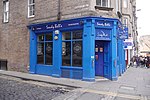Bedlam Theatre

Bedlam Theatre is a fully operational, 90-seat theatre housed in a former Neogothic church at the foot of George IV Bridge in central Edinburgh. It is owned by the University of Edinburgh, and notable for being the oldest student-run theatre in Britain. During the summer, Bedlam Fringe is run as a separate enterprise, Bedlam being a long-standing Edinburgh Fringe venue. Outside the Fringe, Bedlam is run by and home to the Edinburgh University Theatre Company (EUTC). They are so associated with the building that its members are often termed "Bedlamites", though the EUTC can and has staged performances in other venues since moving into Bedlam Theatre. Bedlam and the EUTC have hosted Edinburgh's longest running improvised comedy troupe, The Improverts, since their inception.
Excerpt from the Wikipedia article Bedlam Theatre (License: CC BY-SA 3.0, Authors, Images).Bedlam Theatre
Bristo Place, City of Edinburgh Old Town
Geographical coordinates (GPS) Address External links Nearby Places Show on map
Geographical coordinates (GPS)
| Latitude | Longitude |
|---|---|
| N 55.946247222222 ° | E -3.1907222222222 ° |
Address
Bedlam Theatre
Bristo Place 11B
EH1 1EZ City of Edinburgh, Old Town
Scotland, United Kingdom
Open on Google Maps







